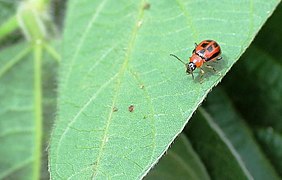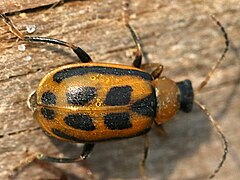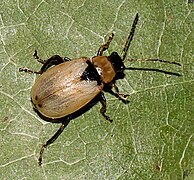
Whiteflies are Hemipterans that typically feed on the undersides of plant leaves. They comprise the family Aleyrodidae, the only family in the superfamily Aleyrodoidea. More than 1550 species have been described.

The Colorado potato beetle is also known as the Colorado beetle, the ten-striped spearman, the ten-lined potato beetle, or the potato bug. It is a major pest of potato crops. It is about 10 mm long, with a bright yellow/orange body and five bold brown stripes along the length of each of its elytra. Native to the Rocky Mountains, it spread rapidly in potato crops across America and then Europe from 1859 onwards.

Diabrotica undecimpunctata, the spotted cucumber beetle or southern corn rootworm, is a species of cucumber beetle that is native to North America. The species can be a major agricultural pest insect in North America. Spotted cucumber beetles cause damage to crops in the larval and adult stages of their life cycle. Larvae feed on the roots of the emerging plants, which causes the most damage since the young plants are more vulnerable. In the adult stage the beetles cause damage by eating the flowers, leaves, stems, and fruits of the plant The beetles can also spread diseases such as bacterial wilt and mosaic virus.

The Mexican bean beetle is a species of lady beetle that can be an agricultural pest. It is one of the few North American lady beetles that feed on plants rather than other insects. It is found throughout Mexico and the eastern United States, and is abundant in the wetter and more heavily irrigated areas west of the Rocky Mountains. It does not tolerate extremely dry areas.
Bean pod mottle virus, or BPMV, is a species of plant pathogenic virus in the family Secoviridae. It is known to infect soybean crops.

Xanthogaleruca luteola, commonly known as the elm-leaf beetle, is a beetle species in the family Chrysomelidae that is native to Europe but invasive in other parts of the world.
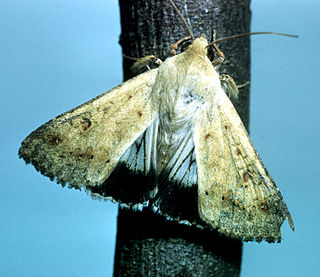
Helicoverpa punctigera, the native budworm, Australian bollworm or Chloridea marmada, is a species of moth in the family Noctuidae. This species is native to Australia. H. punctigera are capable of long-distance migration from their inland Australian habitat towards coastal regions and are an occasional migrant to New Zealand.

The soybean aphid is an insect pest of soybean that is exotic to North America. The soybean aphid is native to Asia. It has been described as a common pest of soybeans in China and as an occasional pest of soybeans in Indonesia, Japan, Korea, Malaysia, the Philippines, and Thailand. The soybean aphid was first documented in North America in Wisconsin in July 2000. Ragsdale et al. (2004) noted that the soybean aphid probably arrived in North America earlier than 2000, but remained undetected for a period of time. Venette and Ragsdale (2004) suggested that Japan probably served as the point of origin for the soybean aphid's North American invasion. By 2003, the soybean aphid had been documented in Delaware, Georgia, Illinois, Indiana, Iowa, Kansas, Kentucky, Michigan, Minnesota, Mississippi, Missouri, Nebraska, New York, North Dakota, Ohio, Pennsylvania, South Dakota, Virginia, West Virginia, and Wisconsin. Together, these states accounted for 89% of the 63,600,000 acres (257,000 km2) of soybean planted in the United States in 2007.
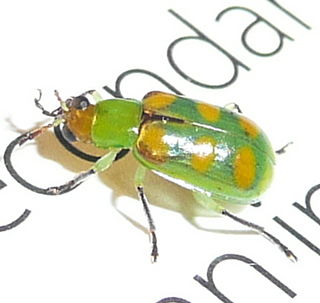
Diabrotica speciosa, also known as the cucurbit beetle and in Spanish as vaquita de San Antonio is an insect pest native to South America. Its larvae feed on the roots of crops. The cucurbit beetle is also known to transmit several viruses such as comoviruses and different mosaic viruses. This is native to South America and is now distributed in Central America and other global areas.

Gonioctena fornicata is a species of broad-shouldered leaf beetles belonging to the family Chrysomelidae, subfamily Chrysomelinae.
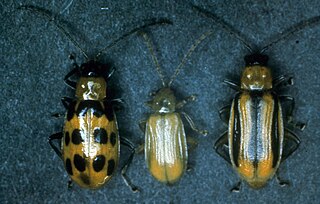
Cucumber beetle is a common name given to members of two genera of beetles, Diabrotica and Acalymma, both in the family Chrysomelidae. The adults can be found on cucurbits such as cucumbers and a variety of other plants. Many are notorious pests of agricultural crops. The larvae of several cucumber beetles are known as corn rootworms.

Diabrotica balteata is a species of cucumber beetle in the family Chrysomelidae known commonly as the banded cucumber beetle. It occurs in the Americas, where its distribution extends from the United States to Colombia and Venezuela in South America. It is also present in Cuba. It is a pest of a variety of agricultural crops.

Gratiana boliviana is a species of beetle in the leaf beetle family, Chrysomelidae. Its common name is tropical soda apple leaf beetle. It is native to South America, where its distribution includes Argentina, Brazil, and Paraguay. It specializes on tropical soda apple, an invasive plant species. It has been released as an agent of biological pest control against the weedy plant in Florida and other parts of the United States.
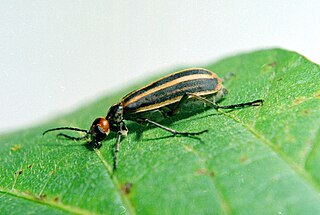
Epicauta vittata is a species of beetle in the family Meloidae, the blister beetles. It is native to eastern North America, including eastern Canada and the eastern United States. It is known commonly as the striped blister beetle and the old-fashioned potato beetle. It is known as an agricultural pest.

Aphis craccivora, variously known as the cowpea aphid, groundnut aphid or black legume aphid, is a true bug in the family Aphididae. Originally of probable Palearctic origin, it is now an invasive species of cosmopolitan distribution.
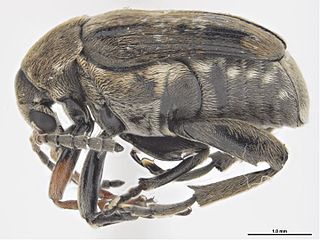
Bruchus rufimanus, commonly known as the broadbean weevil, broadbean beetle, or broadbean seed beetle is a leaf beetle which inhabits crops and fields, as well as some homes. It is a pest of faba beans. The adult beetles feed on pollen, while their larvae tunnel in seeds destroying crops and moving on to new ones once they dry out. The adult beetle, being one of the biggest of its genus, ranges from 3 to 5 mm in length.

Potato leafhopper belongs to family Cicadellidae and genus Empoasca within order Hemiptera. In North America they are a serious agricultural pest. Every year millions of dollars are lost from reduced crop yields and on pest management. Crops that are impacted the most are potatoes, clover, beans, apples and alfalfa.
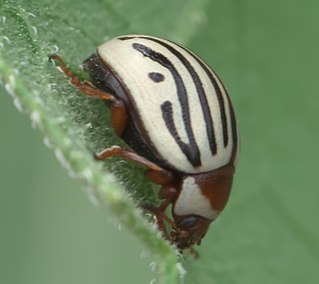
Zygogramma exclamationis, commonly known as the sunflower beetle, is a species of leaf beetle belonging to the family Zygogramma. It is regarded as a pest of sunflower crops in North America.
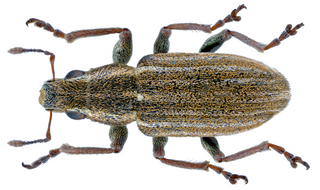
Sitona lineatus, commonly known as the pea leaf weevil is a species of weevil with a Palearctic distribution. It is a common pest of beans, peas, and other plants in the family Fabaceae. Adult beetles of S. lineatus measure 3.4-5.3 mm in length. They are characterized by a series of colored scales arranged in alternating lines (striae) on the elytra; it is from this characteristic where the species gets its name lineatus meaning 'lined' or 'striped'. The head and pronotum also have fine pointed setae amongst the scales. The antennae are clubbed, pointed and preceded by 7 segments. The femora is dark, but tibiae and tarsi are red. As a member of Order Coleoptera (beetles) their forewings are modified to form hardened covers over the thorax and abdomen, with the hindwings for flight underneath.

Bruchus pisorum, known generally as pea weevil, is a species of leaf beetle in the family Chrysomelidae. Other common names include the pea beetle and pea seed beetle. It is found in Europe and Northern Asia, North America, and temperate Asia.

